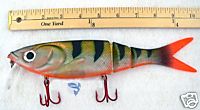Soft plastic lures come in an almost bewildering variety of sizes, shapes, colours and rigging styles but they all have two things in common; part or all of the body is soft and they catch fish. Various types of soft plastics are in common use in the US and are becoming much more common among UK Sea Anglers but Coarse Anglers have been slow to add them to their lure arsenal.
This is the first in a series of guides I will be writing to explain a bit about how the work, why they work, and which ones are likely to fit your needs on a particular water. I chose swim baits because they actually look like a lure that just happens to have a soft body rather than a hard one. It is always more comfortable to start out with something similar to a lure that has worked for you in the past.
What is a Swim Bait: Any of a loose group of soft body lures that emulate baitfish and are frequently characterized by their large size (often life size) in relation to other lures. Some such as the Castaic lures have a hard head and replaceable soft bodies. Others like the Storm lures have a soft head & body. All have some means of making the body tougher so it won’t be ruined by the first fish or two that strike it.
How do you fish a Swim Bait: This is the nice part. Swim baits can be fished in exactly the same way as you would any lipped, sinking crankbait (think Shakespeare Big S plug). Toss it out, count down until it reaches the depth you want at around one foot per second, and reel it in.
The soft and flexible body will give it an action that cannot really be matched by any hard body lure. It will also mean that when a fish strikes, the lifelike feel of the body will usually cause them to hang on longer than when they bite down on a piece of wood or plastic. I’m sure they feel the hooks but just think they have been stuck by a dorsal fin.
Example: Here are some photos of a Storm Kickin Minnow which is excellent for pike, large perch, and a variety of salt water fish.
This 10 inch perch lure weighs 149 gm (5 1/4 oz) so it needs a stout rod for casting. The clear lip at the front gives it a nice wobbling action but is hard for the fish to see.

This top view of a firetiger lure shows the hinged section that adds to the natural look of the lure as a swimming fish. You can see the thinner connecting pieces which are a tough fabric moulded into the full length of the lure body.

Details of the fabric hinge

Tips
- – Match the lure size to whatever forage fish your target species feeds on.
- Rub on a fish scented oil if you are a smoker as it will help mask the tobacco odor on your hands.
- Pike don’t tend to locate prey by smell so the scented oil is not that important when targeting them. Zander and perch do use smell so it might give you an edge when you are after them.
- Vary retrieve speed until you find what the fish want on a given day. Try fast, slow, and erratic where you take 2-3 fast turns on the reel handle then pause for 2-3 seconds and repeat. Watch for signs of a take when you quit reeling. Any twitch on the line or a lure that sinks too slowly probably means a fish had taken it so strike.
- Repair small tears or holes in the lure by heating a piece of metal such as a nail and rubbing the damaged area or by using the flame of a lighter directly on the body for a brief instant.
- Increase the appeal of your lure and make it easier to locate in cloudy water by adding a rattle to the lure. The rattles pictured below have a brass body with several steel balls inside and is easy to insert into the front section of the lure. Brass will not break when a fish takes the lure and these can be easily reused if a lure becomes too damaged to be useful.

Editor’s note: Newt sells a range of bits and pieces on Ebay, some of which you won’t often see on sale in the UK. Click here to visit his current listings.










